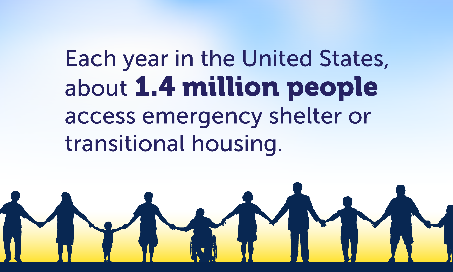Setting the Standard for Housing Data
Updated February 26, 2023

Data experts in CDC’s Public Health Informatics Office (PHIO) and the Special Populations Team in the Office of the Deputy Director for Infectious Diseases (DDID) are working together to establish key building blocks for assessing and collecting data on housing status.
Housing is an important element in the social determinants of health (SDOH), the conditions in the environments where people are born, live, learn, work, play, worship, and age that affect various health, functioning, and quality-of-life outcomes and risks.
When a person’s housing status is uncertain and results in homelessness, their health and well-being can suffer. Additionally, homelessness often makes it harder to address or prevent health problems.
Housing Status and Health
Each year in the United States, at least 1.4 million people experience homelessness, with 580,000 experiencing it on an average night. Research consistently shows that people experiencing homelessness (PEH) or housing insecurity are at increased risk of exposure to infectious diseases and violence; often delay seeking treatment for conditions that later become more serious; and experience higher rates of uncontrolled chronic conditions. For those who are experiencing sheltered homelessness, close living environments can create a greater risk infection during communicable disease outbreaks. During the early days of the COVID-19 pandemic in 2020, homeless shelters in large cities documented COVID-19 rates of over 66%.

These risks are not limited to people experiencing homelessness. Other people housed in congregate settings (e.g., group homes, residential treatment facilities, halfway houses, correctional facilities, and others), can also experience a greater risk for certain health conditions and diseases, including infection during outbreaks. People in various populations, such as people experiencing incarceration, people with disabilities, or people who use drugs or have a substance use disorder, may be both more likely to reside in a congregate setting and more likely to have chronic conditions or other challenges that have an impact on the risk of severe illness due to some infectious diseases.
Housing Data
The connection between housing status and a person’s overall health and well-being suggests collection and analysis of housing status data is imperative to understanding and addressing the health needs of PEH. However, data on housing is often not included or is collected inconsistently in surveillance systems and in clinical electronic health record systems. With better data standards and value sets, public health providers can improve data exchange and integration, more quickly identify outbreaks in congregate settings, and provide interventions tailored to serve people whose housing status puts them at higher risk for adverse health outcomes.
Data Standard for Housing Status
PHIO and the Special Populations Team in DDID are establishing key building blocks to develop a housing status data standard and assessment tools. Activities include:
- Launching a project to pilot the linkage of homeless management information systems and immunization information systems in select jurisdictions to enable the calculation of the vaccination rate among people currently experiencing homelessness in coordination with additional partners in NCIRD and NCHHSTP.
- Identifying strategies to capture housing status, prior history of homelessness, and transitions out of homelessness in electronic health records, electronic case reporting, and surveillance systems.
- Evaluating existing data warehouses where data from multiple systems, including those covering housing and health, are combined to identify key elements, best practices, lessons learned, and value added.
- Understanding how housing and homelessness status are currently captured at the local, state, and federal levels to inform the development of a validated question set.
- Deepening partnerships with public health and clinical care providers to integrate multiple perspectives into recommendations for data collection and integration.
- Developing a white paper that describes the rationale and need for electronic health records to include standard information on housing status.
A longer-term goal is the adoption of housing status or living situation as a United States Core Data for Interoperability (USCDI) data element. Published by the Office of National Coordinator for Health Information Technology (ONC), USCDI is a standardized set of health data classes and constituent data elements used for nationwide, interoperable health information exchange.
The work will also inform the development of screening questions to assess for housing status in diverse settings, including intake for homeless services, public health surveillance systems or case investigations, and survey instruments. An abbreviated version of the screening questions will be developed for potential incorporation into electronic health records to improve care both at the individual and population level.
PHIO’s work directly supports CDC’s Data Modernization Initiative (DMI), a national effort to create real-time public health data and surveillance systems that can protect Americans from any health threat. With better data standards and data systems that collect information on SDOH, public health providers can provide interventions tailored to better serve people who are at higher risk for health problems.
Housing Status: An Important Part of Improving Health Equity
Enhancing data collection on housing status also aligns with CDC’s focus on improving health equity through a thoughtful and comprehensive approach. Public health action can be more focused, timely, and suitable when data reflects the needs of people experiencing homelessness and the intersections between them, taking into consideration that homelessness changes over time.
